Bandersnatch – Lewis & Tolkien as Writers in Community
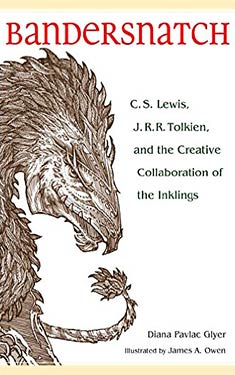 I’ve got to start with a misconception that people who don’t know artists or other creative people often have. Many people think that the creative process starts and ends in the space between the artist and the work. That is, in that space between the blank page and the writer, the blank canvas and the painter, or the raw stone and the sculptor. This is only partially true and this partial truth gives rise to the myth, yes Myth, of the writer in a lonely garret, the Eiffel Tower in the background, out the window. Yes, in that space is where everything collides in the struggle right then and there to create, but any artist will tell you that this point is only 50% of the process. (Some say more, some say less.) There is a wholly different side to the creative process which those who don’t know artists, know nothing about.
I’ve got to start with a misconception that people who don’t know artists or other creative people often have. Many people think that the creative process starts and ends in the space between the artist and the work. That is, in that space between the blank page and the writer, the blank canvas and the painter, or the raw stone and the sculptor. This is only partially true and this partial truth gives rise to the myth, yes Myth, of the writer in a lonely garret, the Eiffel Tower in the background, out the window. Yes, in that space is where everything collides in the struggle right then and there to create, but any artist will tell you that this point is only 50% of the process. (Some say more, some say less.) There is a wholly different side to the creative process which those who don’t know artists, know nothing about.
That is Bandersnatch: the other side where creativity is forged in the crucible of fellowship.
In terms of the 20th century, the Inklings, this select group of men, who met, talked, and critiqued each others work, has now become The Example for how a fellowship is supposed to work. Even Paris of Hemingway’s lost generation, with their salons, and creative minds from far more disciples, seems now a pale second place.
Bandersnatch takes us into this crucible, trying to reconstruct from a fly-on-the-wall perspective this extraordinary time and place. Glyer is concerned with two fundamental questions: What did they talk about when they discussed the various works in progress? and What difference did it make within the books they were writing?
These are simple but seemingly unanswerable questions. Until now, of course. It is positively amazing what a determined scholar can find, especially going into a headwind of opinion from friends, mentors, teachers, that these questions Can Not be answered, so one shouldn’t waste one’s time trying.
Thank goodness she didn’t listen to those little minds. The end result was the book The Company They Keep: Lewis, Tolkien as Writers in Community. Bandersnatch then is not the Good Parts version, the dumbed down for a general audience version, nor a more intimate treatment with the author as narrator version, although all three facets do come into play. Think of Bandersnatch as a distillation with an eye on bringing the practice, that is, the wisdom of The Inklings, into our own lives as creative people.
What did they talk about? What difference did it make? The answer is everything and the other answer is that it made a huge difference. You’ll have to get the details from the book!
For me, the book highlighted not just the critique part of fellowship, but also the resonating aspect, that is, someone who gets it like you get it. If, say, two anime Otaku (obsessed fans of Japanese animation) get together and one of them says “SAO” that’s all they need to engage in a 40 minute conversation concerning the minutia of “SAO” that is as incomprehensible to an outsider as if the outsider was listening to two astrophysicists. From what Glyer has gleamed from The Inklings and from a lot of current research and thought on the subject, this resonating aspect by itself is huge, in terms of creativity.
Glyer goes on to illuminate a half dozen other forms of feedback within the fellowship and what effect it had on the individual writers and their work. She also, fortunately or unfortunately, illuminates what ultimately sunk their ship: what went wrong and why it was their undoing. This, of course, should be a lesson for our own creative process.
If you are a Lewis or Tolkien fan, what are you waiting for? Go and get this book. If you don’t care for those two but the issues surrounding creativity, or writers in general are of interest, this book offers plenty for you as well.
Highly recommended.
Forays into Fantasy: Pulp Fantasy and A. Merritt’s The Ship of Ishtar
Scott Lazerus is a Professor of Economics at Western State Colorado University in Gunnison, Colorado, and has been a science fiction fan since the 1970s. The Forays into Fantasy series is an exploration of the various threads of fantastic literature that have led to the wide variety of fantasy found today, from the perspective of an SF fan newly exploring the fantasy landscape. FiF will examine some of the most interesting landmark books of the past, along with a few of today’s most acclaimed fantasies, building up an understanding of the connections between fantasy’s origins, its touchstones, and its many strands of influence.
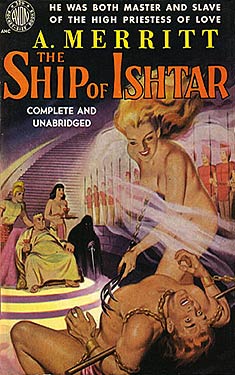 The 1920s saw a peak in interest in fantasy among “literary” writers. Modernist writers like James Joyce (Ulysses, 1922) and T. S. Eliot (The Waste Land, 1922), looking for universal themes among the technological, political, and social upheavals of the early twentieth century, increasingly incorporated mythology into their writing. Other literary writers of the decade took the further step of presenting mythological stories using all the tools of the modern novel. David Lindsay, Hope Mirrlees, Virginia Woolf, David Garnett, E. R. Eddison, Franz Kafka, Lord Dunsany, and James Branch Cabell all produced works that attempted to novelize the fantastic and the mythological.
The 1920s saw a peak in interest in fantasy among “literary” writers. Modernist writers like James Joyce (Ulysses, 1922) and T. S. Eliot (The Waste Land, 1922), looking for universal themes among the technological, political, and social upheavals of the early twentieth century, increasingly incorporated mythology into their writing. Other literary writers of the decade took the further step of presenting mythological stories using all the tools of the modern novel. David Lindsay, Hope Mirrlees, Virginia Woolf, David Garnett, E. R. Eddison, Franz Kafka, Lord Dunsany, and James Branch Cabell all produced works that attempted to novelize the fantastic and the mythological.
While this literary strain of fantasy never entirely died out, it waned in subsequent years, as the second main strain of fantasy—that appearing in the pulp magazines—increased its dominance. The appeal to escapism and sensationalism associated with pulp fantasy and science fiction (as well as some atrocious writing) may have helped make the genre increasingly unacceptable to the literati, but the literary accomplishments of the 1920s are an indicator of what might have been, if the potential audience for these works had not been turned against the literary potential of fantasy by the reputation of the pulps, especially once the specialized genre pulps Weird Tales and Amazing Stories appeared with much success in the late 1920s.
Forays into Fantasy: Arabian Fantasy and G. Willow Wilson’s Alif the Unseen
Scott Lazerus is a Professor of Economics at Western State Colorado University in Gunnison, Colorado, and has been a science fiction fan since the 1970s. The Forays into Fantasy series is an exploration of the various threads of fantastic literature that have led to the wide variety of fantasy found today, from the perspective of an SF fan newly exploring the fantasy landscape. FiF examines some of the most interesting landmark books of the past, along with a few of today’s most acclaimed fantasies, building an understanding of the connections between fantasy’s origins, its touchstones, and its many strands of influence.
Editor’s Note: This post counts as a WoGF review for purposes of the December review poll.
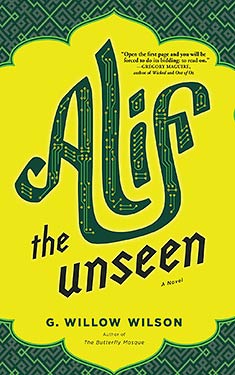 So far, these Forays into Fantasy have mostly ranged from the late nineteenth through the first half of the twentieth century. I’d previously read other seventeenth and eighteenth century fantasies recommended by Moorcock and Cawthorn in Fantasy: The 100 Best Books, a few of which are discussed in this post on the Gothic origins of modern fantasy. My goal for this reading project (along with, hopefully, reading some great books) has been to explore the history of the fantasy genre before beginning to review more modern fantasies, in order to give some historical context to what today’s fantasists are doing. This post will be my first step into the landscape of modern fantasy, with a look at G. Willow Wilson‘s World Fantasy Award-winner Alif the Unseen (2012). A big part of the appeal and originality of this novel is its engagement with current issues in the Middle East. It seems that Wilson, while writing Alif, anticipated the events of the Arab Spring, and the role of computers and social media in those uprisings. But the story also partakes of a fantasy tradition that stretches back to one of the eighteenth century roots of the modern genre—the development of Arabian fantasy subsequent to the appearance of translations of the stories that came to be known as the Arabian Nights. This review may also be the first to make a connection between G. Willow Wilson and L. Ron Hubbard (though I’d love to know if anyone got there before me!).
So far, these Forays into Fantasy have mostly ranged from the late nineteenth through the first half of the twentieth century. I’d previously read other seventeenth and eighteenth century fantasies recommended by Moorcock and Cawthorn in Fantasy: The 100 Best Books, a few of which are discussed in this post on the Gothic origins of modern fantasy. My goal for this reading project (along with, hopefully, reading some great books) has been to explore the history of the fantasy genre before beginning to review more modern fantasies, in order to give some historical context to what today’s fantasists are doing. This post will be my first step into the landscape of modern fantasy, with a look at G. Willow Wilson‘s World Fantasy Award-winner Alif the Unseen (2012). A big part of the appeal and originality of this novel is its engagement with current issues in the Middle East. It seems that Wilson, while writing Alif, anticipated the events of the Arab Spring, and the role of computers and social media in those uprisings. But the story also partakes of a fantasy tradition that stretches back to one of the eighteenth century roots of the modern genre—the development of Arabian fantasy subsequent to the appearance of translations of the stories that came to be known as the Arabian Nights. This review may also be the first to make a connection between G. Willow Wilson and L. Ron Hubbard (though I’d love to know if anyone got there before me!).
Forays into Fantasy: Fritz Leiber’s Conjure Wife and the Beginnings of Urban Fantasy
Scott Lazerus is a Professor of Economics at Western State Colorado University in Gunnison, Colorado, and has been a science fiction fan since the 1970s. The Forays into Fantasy series is an exploration of the various threads of fantastic literature that have led to the wide variety of fantasy found today, from the perspective of an SF fan newly exploring the fantasy landscape. FiF examines some of the most interesting landmark books of the past, along with a few of today’s most acclaimed fantasies, building an understanding of the connections between fantasy’s origins, its touchstones, and its many strands of influence.
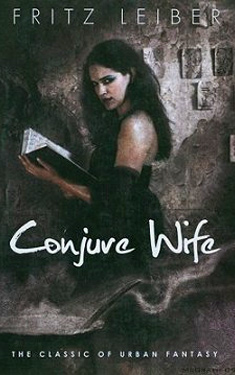 Fritz Leiber (1910–1992) is indisputably one of the most important science fiction and fantasy writers of the twentieth century, recipient of the Science Fiction Writers of America’s Grand Master Award and the World Fantasy Award for Lifetime Achievement, as well as six Hugos and four Nebulas. His science fiction is some of the best of its era, including Gather, Darkness (1943), Hugo winner The Big Time (1958), and a series of great short stories for Galaxy during the 1950s. Despite his achievements in SF, he is better known today for his fantasy, due primarily to his sword and sorcery sequence featuring Fafhrd and the Gray Mouser, which began with “Two Sought Adventure” (aka “The Jewels in the Forest”) in 1939, and continued throughout his long career (and which should be the subject for a future post in this series).
Fritz Leiber (1910–1992) is indisputably one of the most important science fiction and fantasy writers of the twentieth century, recipient of the Science Fiction Writers of America’s Grand Master Award and the World Fantasy Award for Lifetime Achievement, as well as six Hugos and four Nebulas. His science fiction is some of the best of its era, including Gather, Darkness (1943), Hugo winner The Big Time (1958), and a series of great short stories for Galaxy during the 1950s. Despite his achievements in SF, he is better known today for his fantasy, due primarily to his sword and sorcery sequence featuring Fafhrd and the Gray Mouser, which began with “Two Sought Adventure” (aka “The Jewels in the Forest”) in 1939, and continued throughout his long career (and which should be the subject for a future post in this series).
Leiber may also have been more comfortable writing fantasy, turning to science fiction at least in part due to the lack of fantasy publishing outlets following the demise of John W. Campbell’s Unknown magazine in 1943, after which science fiction would dominate the genre magazine (and eventually the book publishing) landscape until the 1970s. Due to Unknown’s market for sophisticated fantasy, the years 1939 to 1943 produced a disproportionate amount of great fantasy, much of which is still read today. Last year I wrote about three of these—Fletcher Pratt and L. Sprague de Camp’s Enchanter stories, Jack Williamson’s Darker Than You Think, and A. E. Van Vogt’s The Book of Ptath—and as I return to this period in the history of fantasy, several additional Unknown stories will be looked at. Along with the first five Fafhrd and the Gray Mouser stories, Fritz Leiber’s contributions to Unknown include the classic “Smoke Ghost” (1941) and the novel Conjure Wife (1943), which was first published in book form, slightly revised and updated, in 1952 as part of the omnibus Witches Three.
Forays into Fantasy: David Lindsay’s A Voyage to Arcturus
Scott Lazerus is a Professor of Economics at Western State Colorado University in Gunnison, Colorado, and has been a science fiction fan since the 1970s. The Forays into Fantasy series is an exploration of the various threads of fantastic literature that have led to the wide variety of fantasy found today, from the perspective of an SF fan newly exploring the fantasy landscape. FiF examines some of the most interesting landmark books of the past, along with a few of today’s most acclaimed fantasies, building an understanding of the connections between fantasy’s origins, its touchstones, and its many strands of influence.
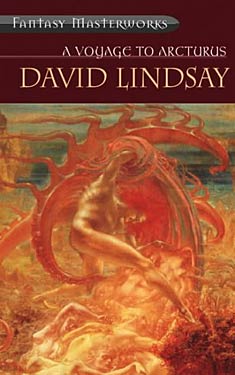 David Lindsay (1876-1945), born in Scotland and relocated to London, was successful in the insurance industry prior to World War I, in which he served, despite being forty years old upon enlistment. The effect of the unprecedented suffering and destruction of the Great War on those who served in it, and on European society, was profound. Whether or not his wartime experience was the impetus, Lindsay decided after the war, despite his age and previous business success, to attempt a full-time writing career, publishing his first novel, A Voyage to Arcturus, in 1920, at which time it was nearly ignored, selling a grand total of 596 copies before slipping into obscurity. His subsequent novels also sold poorly, and he was unable to publish anything after 1932, dying in 1945 as the result of an abscess related to dental neglect.
David Lindsay (1876-1945), born in Scotland and relocated to London, was successful in the insurance industry prior to World War I, in which he served, despite being forty years old upon enlistment. The effect of the unprecedented suffering and destruction of the Great War on those who served in it, and on European society, was profound. Whether or not his wartime experience was the impetus, Lindsay decided after the war, despite his age and previous business success, to attempt a full-time writing career, publishing his first novel, A Voyage to Arcturus, in 1920, at which time it was nearly ignored, selling a grand total of 596 copies before slipping into obscurity. His subsequent novels also sold poorly, and he was unable to publish anything after 1932, dying in 1945 as the result of an abscess related to dental neglect.
A Voyage to Arcturus, however, was not entirely forgotten, and the novel gained influential proponents, especially C. S. Lewis, who credited the novel as a major inspiration for Out of the Silent Planet (1938) and its two sequels, which picked up on Lindsay’s use of a foreign planet as a setting for metaphysical speculation. It was reprinted in the United Kingdom in 1946, finally receiving a U.S. publication in 1963, followed by a Ballantine paperback reissue in 1968 as part of that publisher’s effort to capitalize on the huge success of the paperback publication of The Lord of the Rings by reprinting other older fantasy works. It has remained in print ever since, being chosen by James Cawthorn and Michael Moorcock as one of the hundred best fantasy novels for their 1991 book, and entering the Fantasy Masterworks collection in 2003. In fact, it shows up on just about every critical list of important fantasy novels. It is now in the public domain, and so easily available, including by way of free electronic editions, a good example of which can be found here.
Forays into Fantasy: Gertrude Barrows Bennett’s The Citadel of Fear
Scott Lazerus is a Professor of Economics at Western State Colorado University in Gunnison, Colorado, and has been a science fiction fan since the 1970s. The Forays into Fantasy series is an exploration of the various threads of fantastic literature that have led to the wide variety of fantasy found today, from the perspective of an SF fan newly exploring the fantasy landscape. FiF will examine some of the most interesting landmark books of the past, along with a few of today’s most acclaimed fantasies, building an understanding of the connections between fantasy’s origins, its touchstones, and its many strands of influence.
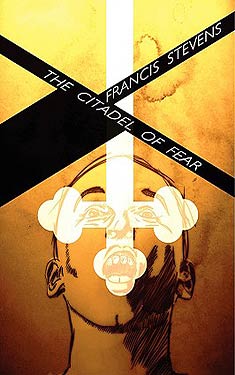 In the midst of the Women of Genre Fiction Challenge, I’d like to direct your attention to Gertrude Barrows Bennett—possibly the most important female writer of speculative fiction that you’ve probably never heard of. Her sustained run of fantasy fiction published between 1917 and 1923—around a dozen stories, including five novels—have led to a growing acceptance of her importance to the history of the genre, following decades of neglect.
In the midst of the Women of Genre Fiction Challenge, I’d like to direct your attention to Gertrude Barrows Bennett—possibly the most important female writer of speculative fiction that you’ve probably never heard of. Her sustained run of fantasy fiction published between 1917 and 1923—around a dozen stories, including five novels—have led to a growing acceptance of her importance to the history of the genre, following decades of neglect.
Bennett (1884–1948) turned to writing when her journalist/explorer husband died while on an expedition, soon followed by her father, leaving her with a newborn daughter and invalid mother to support. She seems to have stopped writing after her mother’s death. Following her disappearance from public view, and prior to the idea being debunked in 1952, it was quite widely believed that Francis Stevens—the pseudonym under which Bennett’s work was published—was actually a penname of A. Merritt, probably the most popular and influential fantasy writer of the first third of the twentieth century (though much less well-known today). It turns out; however, that the similarities of their writings, which led readers to assume “Stevens” was Merritt, were quite likely the result of Bennett’s own influence on Merritt, who acknowledged his admiration for her works, and the inspiration he received from them. (Mention has also been made of H. P. Lovecraft’s endorsement of her work, but this story seems to have been apocryphal.)
Forays into Fantasy: Mervyn Peake’s Gormenghast
Scott Lazerus is a Professor of Economics at Western State Colorado University in Gunnison, Colorado, and has been a science fiction fan since the 1970s. The Forays into Fantasy series is an exploration of the various threads of fantastic literature that have led to the wide variety of fantasy found today, from the perspective of an SF fan newly exploring the fantasy landscape. FiF will examine some of the most interesting landmark books of the past, along with a few of today’s most acclaimed fantasies, in an attempt to understand the connections between fantasy’s origins, its touchstones, and its many strands of influence.
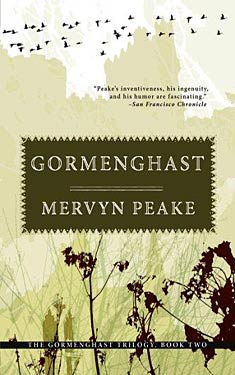 Gormenghast was released in 1950, the same year as The Lion, the Witch, and the Wardrobe. The Lord of the Rings would soon follow. These latter two works may be seen as the defining fantasies of the second half of the twentieth century, altering the landscape of the field, popularizing the secondary world fantasy and setting the stage for the advent of fantasy as a commercial genre in the late 1960s. As well as developing an enduring popularity that continues into the present, these books (especially, or course, The Lord of the Rings) have been more influential on fantasy literature than anything since. And yet, though it is not read as widely as these two contemporaries, Mervyn Peake’s Gormenghast novels, conceived in that same post-war period in England, seem to me to be just as important. Unlike Tolkien and Lewis, Peake has not inspired hordes of imitators or greatly influenced the direction of commercial fantasy. The influence of Mervyn Peake could not be based on imitating the plot structure or external trappings of his creation—the books are too idiosyncratic for that to be a temptation. Rather, the strand of Peake’s influence can be seen in those writers of modern fantasy who have rejected the commercial allure of Tolkien-like epic fantasy in order to pursue their own personal fantastic visions, and those for whom character, theme, and style are at least as important as plot and exterior world-building.
Gormenghast was released in 1950, the same year as The Lion, the Witch, and the Wardrobe. The Lord of the Rings would soon follow. These latter two works may be seen as the defining fantasies of the second half of the twentieth century, altering the landscape of the field, popularizing the secondary world fantasy and setting the stage for the advent of fantasy as a commercial genre in the late 1960s. As well as developing an enduring popularity that continues into the present, these books (especially, or course, The Lord of the Rings) have been more influential on fantasy literature than anything since. And yet, though it is not read as widely as these two contemporaries, Mervyn Peake’s Gormenghast novels, conceived in that same post-war period in England, seem to me to be just as important. Unlike Tolkien and Lewis, Peake has not inspired hordes of imitators or greatly influenced the direction of commercial fantasy. The influence of Mervyn Peake could not be based on imitating the plot structure or external trappings of his creation—the books are too idiosyncratic for that to be a temptation. Rather, the strand of Peake’s influence can be seen in those writers of modern fantasy who have rejected the commercial allure of Tolkien-like epic fantasy in order to pursue their own personal fantastic visions, and those for whom character, theme, and style are at least as important as plot and exterior world-building.
This is not to say that world-building is not important in Peake’s works, but it is not of the sort that epic fantasy fans will be looking for. The inhabitants of Gormenghast can only be defined in relation to the environment their forebears created for them, and this environment—Gormenghast castle and it’s immediate natural surroundings—is described in such visual terms that the setting is evoked in a way rarely achieved, and this setting is arguably more interesting than any individual character. But this world-building is focused interiorly on the isolated castle. There’s no need for a map to track the characters’ progress, and the outside world is never described in the first two Gormenghast novels. This aspect adds to the strangeness and dislocation created by Peake’s writing, since the reader knows nothing of the larger world in which Gormenghast is situated. The result is a strange combination of dislocation and concreteness. We do not know where or when Gormenghast exists, yet it comes to seem entirely real on its own terms. The concreteness of the castle setting is further enhanced by the fact that Gormenghast seemingly has not changed for centuries, possibly millennia (aside from a slow deterioration), and it is this fact that creates the conflict that first become apparent in the first Gormenghast novel, Titus Groan (1946, see previous post), and comes to a head in the second, Gormenghast (1950).
Forays into Fantasy: William Hope Hodgson’s The Night Land
Scott Lazerus is a Professor of Economics at Western State Colorado University in Gunnison, Colorado, and has been a science fiction fan since the 1970s. The Forays into Fantasy series is an exploration of the various threads of fantastic literature that have led to the wide variety of fantasy found today, from the perspective of an SF fan newly exploring the fantasy landscape. FiF will examine some of the most interesting landmark books of the past, along with a few of today’s most acclaimed fantasies, in an attempt to understand the connections between fantasy’s origins, its touchstones, and its many strands of influence.
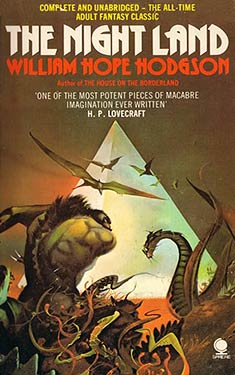 In an earlier Foray into Fantasy, I looked at William Hope Hodgson’s The House on the Borderland (1908) as an influential early precursor of the weird tale, a difficult-to-define subgenre of fantasy portraying incursions of the inexplicable or uncanny into our consensual reality. Since then, I’ve been looking forward to reading The Night Land (1912), Hodgson’s fourth and final novel, which, though sometimes cited as his masterpiece, is not as often read today due to its length and distracting pseudo-archaic English. While it certainly has touches of the weird, The Night Land is also an amalgamation of fantasy, science fiction, horror, and romance, its uniqueness compounded by its extremely unusual narrative viewpoint.
In an earlier Foray into Fantasy, I looked at William Hope Hodgson’s The House on the Borderland (1908) as an influential early precursor of the weird tale, a difficult-to-define subgenre of fantasy portraying incursions of the inexplicable or uncanny into our consensual reality. Since then, I’ve been looking forward to reading The Night Land (1912), Hodgson’s fourth and final novel, which, though sometimes cited as his masterpiece, is not as often read today due to its length and distracting pseudo-archaic English. While it certainly has touches of the weird, The Night Land is also an amalgamation of fantasy, science fiction, horror, and romance, its uniqueness compounded by its extremely unusual narrative viewpoint.
The first chapter tells of the courtship and marriage of Mirdath and the unnamed narrator. Based on the writing style and details of the setting, it seems to take place in England in the seventeenth century, though this is not specified. When Mirdath dies in childbirth, the narrator, who idealized his wife with an intense degree of sentimentality, is plunged into despair. Somehow, whether through some form of clairvoyant reincarnation or psychic time travel (the ambiguous possibility of both mystical and science fictional interpretations is characteristic of the novel), he finds himself occupying the mind of a young man living on the dying earth millions of years in the future, after the sun has stopped emitting visible light, and humanity has retreated into the “Great Redoubt”—a giant metal pyramid powered by the “Earth Current” and protected from the malevolent forces of the Night Land by a sort of force field. The remainder of the novel is narrated from the perspective of this seventeenth century Englishman, now with the knowledge of the young man of the future whose mind he co-occupies, describing this future dying earth and his quest to regain his lost love—a journey through a blighted landscape teeming with evil creatures.
Forays into Fantasy: Charlotte Perkins Gilman’s Herland
Scott Lazerus is a Professor of Economics at Western State Colorado University in Gunnison, Colorado, and has been a science fiction fan since the 1970s. The Forays into Fantasy series is an exploration of the various threads of fantastic literature that have led to the wide variety of fantasy found today, from the perspective of an SF fan newly exploring the fantasy landscape. FiF will examine some of the most interesting landmark books of the past, along with a few of today’s most acclaimed fantasies, building up an understanding of the connections between fantasy’s origins, its touchstones, and its many strands of influence.
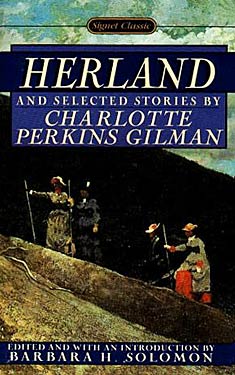 With its ability to portray worlds and societies unconstrained by the realities of our experience, speculative fiction has always been a venue for criticizing or championing political systems, real and imagined. At the turn of the twentieth century, at the same time that commercial fantasy was moving in the direction of Burroughsian adventure, sword and sorcery and the weird tale, fantasy was also still being written by authors outside the pulp ghetto that was just beginning to establish itself. During this same period, the triumph of large-scale industrial capitalism in the United States was resulting in a political counter-reaction in the form of populist and socialist movements looking to alter or replace this system, as well as social reform movements working to ameliorate the growing problem of urban poverty that accompanied the creation of previously unheard-of concentrations of wealth by the “robber barons” of the Gilded Age. Socialists such as Jack London, with his anti-capitalist dystopia The Iron Heel (1908), and Edward Bellamy, with his best-selling socialist utopia Looking Backward, 2000–1887 (1889), used fantastic fiction to criticize American economic conditions, and attempted to inspire alternative social movements. Such books were widely read by an audience that would have been mostly uninterested in the pulp fantasy starting to appear around the same time, and are representative of the end of an era in which fantastika was one of many fictional modes used by authors as diverse and widely respected as Mark Twain, Nathaniel Hawthorne, and Henry James.
With its ability to portray worlds and societies unconstrained by the realities of our experience, speculative fiction has always been a venue for criticizing or championing political systems, real and imagined. At the turn of the twentieth century, at the same time that commercial fantasy was moving in the direction of Burroughsian adventure, sword and sorcery and the weird tale, fantasy was also still being written by authors outside the pulp ghetto that was just beginning to establish itself. During this same period, the triumph of large-scale industrial capitalism in the United States was resulting in a political counter-reaction in the form of populist and socialist movements looking to alter or replace this system, as well as social reform movements working to ameliorate the growing problem of urban poverty that accompanied the creation of previously unheard-of concentrations of wealth by the “robber barons” of the Gilded Age. Socialists such as Jack London, with his anti-capitalist dystopia The Iron Heel (1908), and Edward Bellamy, with his best-selling socialist utopia Looking Backward, 2000–1887 (1889), used fantastic fiction to criticize American economic conditions, and attempted to inspire alternative social movements. Such books were widely read by an audience that would have been mostly uninterested in the pulp fantasy starting to appear around the same time, and are representative of the end of an era in which fantastika was one of many fictional modes used by authors as diverse and widely respected as Mark Twain, Nathaniel Hawthorne, and Henry James.
Forays into Fantasy: C. S. Lewis’s The Lion, the Witch and the Wardrobe
Scott Lazerus is a Professor of Economics at Western State Colorado University in Gunnison, Colorado, and has been a science fiction fan since the 1970s. The Forays into Fantasy series is an exploration of the various threads of fantastic literature that have led to the wide variety of fantasy found today, from the perspective of an SF fan newly exploring the fantasy landscape. FiF will examine some of the most interesting landmark books of the past, along with a few of today’s most acclaimed fantasies, building up an understanding of the connections between fantasy’s origins, its touchstones, and its many strands of influence.
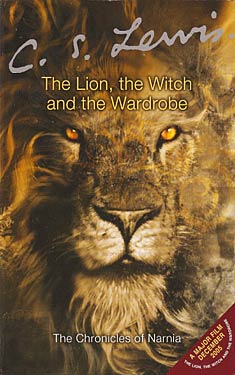 Between them, J. R. R. Tolkien and C. S. Lewis have been credited with reinventing and reinvigorating fantasy literature for the second half of the twentieth century, both creatively and, ultimately, commercially. Amazingly, the two writers most influential on modern fantasy were both professors of medieval language and literature at Oxford University, as well as being good friends, during the period in which they wrote, respectively, The Lord of the Rings and The Chronicles of Narnia. Both were members of an informal reading and writing group known as the Inklings, where they discussed their works in progress and their ideas about fantasy. The two were also bound by the shared experience of fighting in the trenches of World War I, and by their devotion to Christianity. In 1931, Tolkien was among those who helped convert the atheist Lewis, though Lewis did not embrace Tolkien’s Catholicism. The religious background of an author is not something that will come up often in my survey of fantasy, but in this case it is relevant to an understanding of Lewis’s work, nearly all of which is related to his religious ideas in some way.
Between them, J. R. R. Tolkien and C. S. Lewis have been credited with reinventing and reinvigorating fantasy literature for the second half of the twentieth century, both creatively and, ultimately, commercially. Amazingly, the two writers most influential on modern fantasy were both professors of medieval language and literature at Oxford University, as well as being good friends, during the period in which they wrote, respectively, The Lord of the Rings and The Chronicles of Narnia. Both were members of an informal reading and writing group known as the Inklings, where they discussed their works in progress and their ideas about fantasy. The two were also bound by the shared experience of fighting in the trenches of World War I, and by their devotion to Christianity. In 1931, Tolkien was among those who helped convert the atheist Lewis, though Lewis did not embrace Tolkien’s Catholicism. The religious background of an author is not something that will come up often in my survey of fantasy, but in this case it is relevant to an understanding of Lewis’s work, nearly all of which is related to his religious ideas in some way.
Given their many affinities, then, it may come as a surprise that Tolkien expressed strong dislike for The Lion, the Witch and the Wardrobe (1950), and the six subsequent Narnia volumes. Yet comparing it to Tolkien’s work may explain why. Tolkien, after all, is heralded as the master of what has come to be known as world-building, spending years inventing the languages, history, and geography of Middle Earth prior to writing The Lord of the Rings. This world building is probably the most influential aspect of his work, its popularity creating a large readership that would subsequently be accustomed to accepting secondary world fantasies—stories set in imagined lands with no necessary connection to ours—as a genre in itself. Fans demanded more of it, leading to the fantasy publishing boom that began after the paperback publication of The Lord of the Rings in the late ‘60s.



















 Full Details
Full Details


